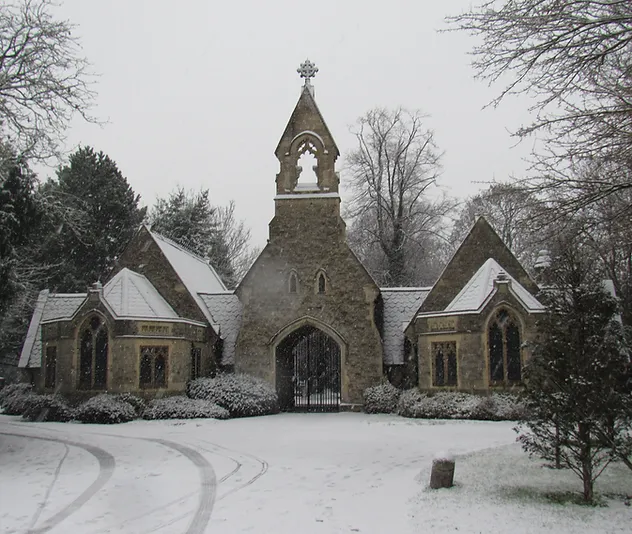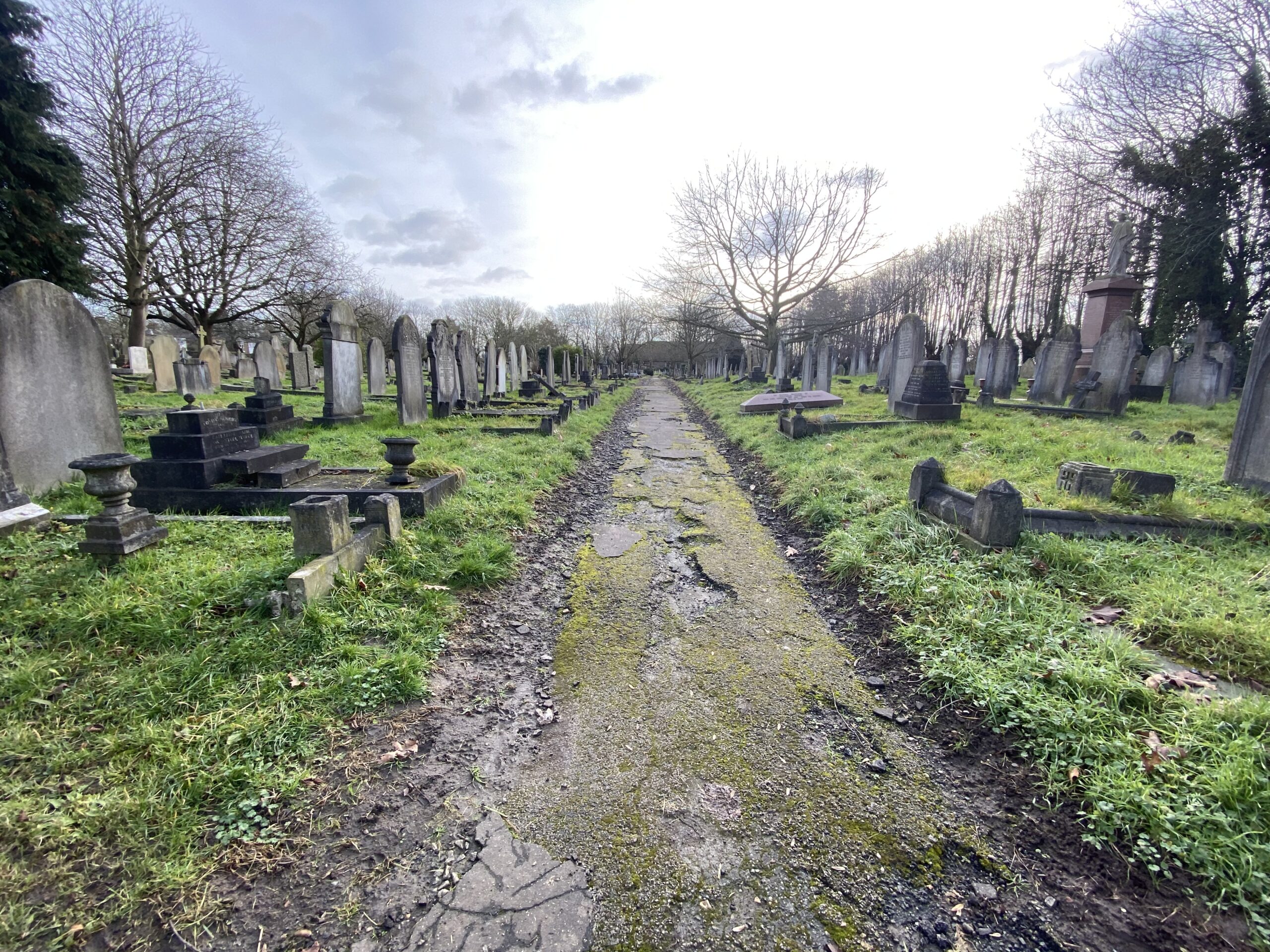
Tottenham Cemetery sits at the heart of one of the most deprived boroughs in London. It is a place of calm, amidst the hustle and bustle of urban life. It is a place where residents and visitors can walk in 62 acres woodland paths, view a rare glimpse of the Moselle River or sit by the Lake watching the wildlife at play.
It has been a working Cemetery since 1858. There is free public access to the Cemetery throughout the year so everyone can come and enjoy this oasis of peace and greenery which tells the story of Tottenham and its people over the centuries.
Visiting Tottenham Cemetery
Address
White Hart Lane
Tottenham
Greater London
N17
Telephone
020 8363 8324
Opening Hours
May – Sept 8.00am – 6.00pm
Oct – Apr 8.00am – 4.30pm
Parking
Cars are allowed into the Cemetery and can Park in designated areas.
Public Transport
Bus: W3 stops near the entrance.
Rail: White Hart Lane Railway station is half a mile from the White Hart Lane and 500m from the smaller pedestrian Beaufoy Road entrance.
History of the Cemetery
1857 The closure of All Hallows Parish Church for burials.
1858 Tottenham Cemetery opened by Tottenham Burial Board in response to the growth of industrial London and the shortage of burial ground The layout was influenced by the designs of John Claudius Loudon whose treatise published in 1843 favoured a grid structure with singularly planted trees to maximise burial space.
A pair of Mortuary Chapels linked by a carriageway were built to serve both Anglican and Non- Conformist burials and the main entrance to the Cemetery was via a carriageway in Cemetery Road.
1913 At this time there stood a grand mansion with extensive grounds in the White Hart Lane area known as Tottenham Park. When the house fell into decline after the First World War the land was bought by Tottenham Urban Council for development as a housing estate and the Cemetery was extended to include the Lake which had been a feature of the mansion house ‘s pleasure gardens.
1922 The War Memorial commemorating the lives lost in WWI was incorporated into the landscape and dedicated.
1926 Cemetery Lodge (now Haringey Mortuary) was built and a formal entrance was opened in Church Lane.
1952 The area around the Lake was landscaped as a remembrance site “Garden of Peace’ for those who lost their lives in World War II.
1976 The Cemetery and surrounding area was awarded Conservation Area status.
2015 A small adjoining area of land in Cemetery Road was opened for burials and is known as Bruce Castle View.
Heritage Features
THE CHAPELS
The Chapels were designed by George E Pritchett (1824 – 1912) and would have been approached through a carriageway entrance flanked by four stone pillars. They are designed in a simple decorated Gothic Style, built in Kentish ragstone with ashlar dressings, and have fishscale slate roofs with iron crestings. The Chapels are identical, each consisting of three bays, with a lower angled apse and with a porch each side that gives a strong cross-axis to the composition. The Carriage Arch is vaulted with stone fribs and bosses. In recent years the brink work and windows have been vandalised. Metal gates were added by Dignity in 2018 to deter anti social behaviour.
THE TUNNEL
The Tunnel is Grade II listed. It joins the two parts of the Cemetery consisting of two flights of stone steps and a segmental stone arch supporting a rock-faced stone wall with a stepped coping with a plaque bearing a trefoil and the date (1883). It has been closed by Dignity owing to the need for repairs.
MONUMENTS
The Cross of Sacrifice was devised in 1919 by Sir Reginal Blomfield for the Imperial (now Commonwealth) War Graves Commission (CWGC) which is widely used across Britain and Europe. It consists of a Portland stone cross with a bronze sword on an octagonal stepped plinth. Behind is a stone screen wall bearing the names of those buried within the Cemetery which was restored to commemorate the centenary of WWI.
Opposite the Cross of Sacrifice there is a large stone memorial dedicated to the memory of men who lost their lives in service to the London Fire Brigade. Close to this area is a large marble slate which is dedicated to the Labour MP and activist, Bernie Grant.
Across the Moselle Brook bridge is another memorial to civilians who lost their lives in WW2. It is built in brick with a molded coping stone with two side walls inscribed with names.
THE GARDEN OF PEACE & LAKE
The Garden of Peace has a different character to the rest of the Cemetery.It is based across the Lake and it follows in the traditional English landscape tradition with its informality and a cultivated natural appearance. The best views feature a serpentine lake surrounded by mature trees including several large weeping willows. The entrance to the Garden is on White Hart Lane which comprises a brick quadrant wall with a Portland Stone frieze inscribed Garden of Peace. During the Summer months a small waterfall runs from the top of the Garden into the Lake.
In 2015 the Lake was re-designed. Originally there were two islands for nesting birds. This was reduced to one and the silt removed was used to create a reed bed. This has created significant issues which the Friends are addressing.
MOSELLE BROOK
The Moselle Brook, whose name derives from ‘Mosse-Hill’ (Muswell Hill), the location of one of the brook’s sources, ran its course north eastwards from Hornsey, meandering through Broadwater Farm (Lordship Recreation Ground) curving eastwards towards the High Road and White Hart Lane. The brook was incrementally culverted in the 18th and 19th centuries. The section running east-west through Tottenham Cemetery is one of the oldest un-culverted parts to survive.
Famous Lives
There are few large monuments compared to other Victorian Cemeteries. However there are 46,000 graves in Tottenham Cemetery and every single one has a story. These are just a few:
-
WILLIAM BUTTERFIELD – THE ARCHITECT
-
Born 7 Sep 1814, London
-
Died 23 Feb, 1900, London
-
GRAVE LOCATION
A British Architect, prominent in the Gothic Revival. Butterfield introduced an architectural realism that included a clear expression of materials in colourful contrasts of textures and patterns. Butterfield’s “structural polychromy” became the fashion of the late Victorian period. He designed over 100 churches. His few secular works include Keble College, Oxford which was completed in 1876. Butterfield received the RIBA Gold Medal in 1884. There is a Blue Plaque on his house in Bedford Square. Although he lived in Bloomsbury, he was buried in Tottenham Cemetery where he had been a constant attendant at All Hallows Church, which he had practically rebuilt. Butterfield designed his own Memorial in the form of a simple medieval stone coffin with a sculpted relief cross.
-
ALFRED EDWARD DURRANTE – THE SOLDIER
-
Born 2 Nov 1864 City of Westminster
-
Died 29 Mar 1933 (age 68) Tottenham, London Borough of Haringey
-
PLOT LOCATION: 221
Second Boer War Victoria Cross Recipient. During the war on August 27, 1900 at Bergendal near Johannesburg, a corporal who had been wounded, rose from his prone position and started to run towards the enemy. Private Durrant pulled him down and tried to keep him quiet. This proved impossible, so he carried him back for 200 yards, under heavy fire, to shelter. Durrant then returned to his place in the line. Later, he was promoted to Lance-Corporal. In addition to his Victoria Cross, which is on display at the Royal Green Jackets Museum in Winchester, he held the Imperial Service Medal.
-
JOHN ELIOT HOWARD – THE SCIENTIST
-
Born 11 Dec 1807
-
Died 22 Nov 1883
-
PLOT LOCATION
John Eliot Howard was an English chemist of the nineteenth century, who conducted pioneering work with the development of Quinine – a medication used to treat malaria.. Howard was the son of Luke Howard, a noted Local Quaker meteorologist and chemist known as the ‘man who named the clouds’. There is a portrait in the National Gallery of father and son. John worked at the family pharmaceutical manufacturing business of Howards and Sons. He was elected a Fellow of the Royal Society in June 1874.
Howard married Maria Crewdson and the couple had seven children, including Joseph Howard, who was later Liberal MP for Tottenham. The family lived at Lord’s Meade, Lordship Lane, Tottenham. Howard died in Edmonton, London at the age of 76. One of his grandchildren was the ornithologist, Henry Eliot Howard.
